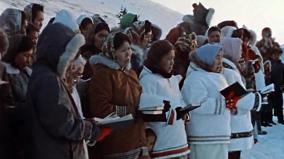New release
Coming
None
At the Spring Sea Ice Camp: Part 1
1967
26 min
Leaving soon
Filmed over a period of three years, from summer 1963 to the late winter of 1965, and released in 1967, the Netsilik series is about the traditional lifestyle of Netsilingmiut living in the area around Kugaaruk. Families travel across the sea ice. Before night falls, they build igloos. A boy practices throwing his spear at a figure he has made in the snow. A woman crimps the sole of a sealskin boot she is making. Please note that this is an archival film that makes use of the word “Eskimo,” an outdated and offensive term. While the origin of the …

Details
Filmed over a period of three years, from summer 1963 to the late winter of 1965, and released in 1967, the Netsilik series is about the traditional lifestyle of Netsilingmiut living in the area around Kugaaruk.
Families travel across the sea ice. Before night falls, they build igloos. A boy practices throwing his spear at a figure he has made in the snow. A woman crimps the sole of a sealskin boot she is making.
Please note that this is an archival film that makes use of the word “Eskimo,” an outdated and offensive term. While the origin of the word is a matter of some contention, it is no longer used in Canada. The term was formally rejected by the Inuit Circumpolar Council in 1980 and has subsequently not been in use at the NFB for decades. This film is therefore a time-capsule of a bygone era, presented in its original version. The NFB apologizes for the offence caused.
Families travel across the sea ice. Before night falls, they build igloos. A boy practices throwing his spear at a figure he has made in the snow. A woman crimps the sole of a sealskin boot she is making.
Please note that this is an archival film that makes use of the word “Eskimo,” an outdated and offensive term. While the origin of the word is a matter of some contention, it is no longer used in Canada. The term was formally rejected by the Inuit Circumpolar Council in 1980 and has subsequently not been in use at the NFB for decades. This film is therefore a time-capsule of a bygone era, presented in its original version. The NFB apologizes for the offence caused.
-
directorQuentin Brown
-
producerQuentin Brown
-
executive producerKevin Smith
-
consultantAsen BalikciGuy Mary-Rousselière
-
cameraRichard BergmanKen CampbellKen PostDouglas WilkinsonRobert Young
-
soundJacques Drouin
-
editingElvin CariniMichel ChalifourWilliam GaddisJack HirschfieldBill Tannebring
-
sound editingMalca GillsonKen PageDon Wellington

















